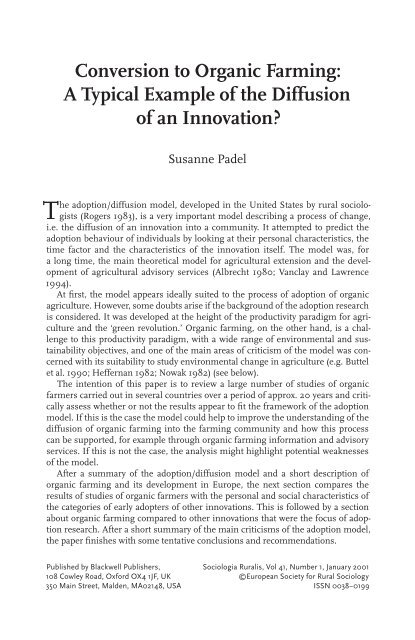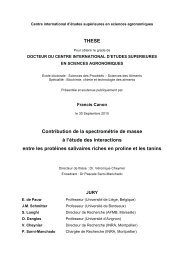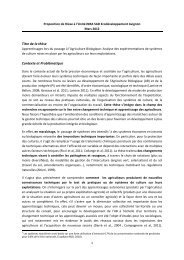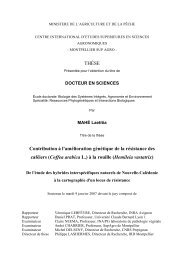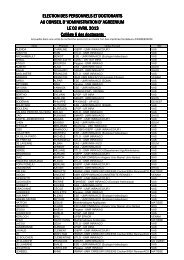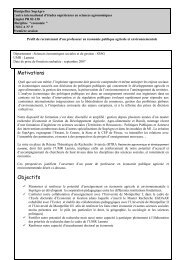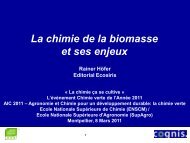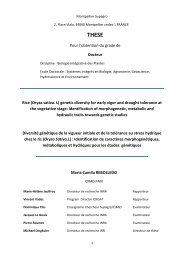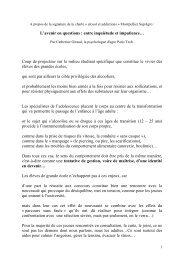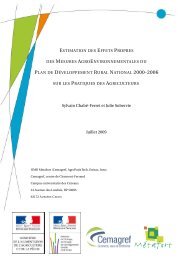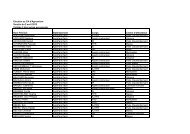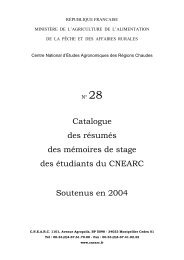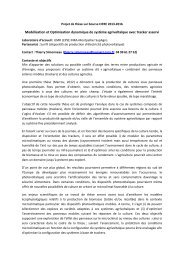Conversion to Organic Farming: A Typical Example of the Diffusion ...
Conversion to Organic Farming: A Typical Example of the Diffusion ...
Conversion to Organic Farming: A Typical Example of the Diffusion ...
You also want an ePaper? Increase the reach of your titles
YUMPU automatically turns print PDFs into web optimized ePapers that Google loves.
Figure 4(1985-1999)605040Average farm size <strong>Conversion</strong> <strong>of</strong> organic <strong>to</strong> <strong>Organic</strong> farms in<strong>Farming</strong><strong>the</strong> EU, Germany and Denmark 45haDKDE3020EU10085 86 87 88 89 90 91 92 93 94 95 96 97 98YearestFigure 3: Average farm size <strong>of</strong> organic farms in <strong>the</strong> eu, Germany and Denmark, 1985-1999Sources: Own calculations based on Lampkin (2000). Arrows show <strong>the</strong> point where <strong>the</strong> farmsize becomes larger than <strong>the</strong> conventional average size for holdings for 1995Arrows show <strong>the</strong> point where <strong>the</strong> farm size becomes larger than <strong>the</strong> conventional average size for holdingsfor 1995However, several older German studies and one study from <strong>the</strong> usa found organicSource: farms Own calculations <strong>to</strong> be larger based than conventional on Lampkin holdings (2000) (Boeckenh<strong>of</strong>f et al. 1986; Dabbert1990b; Wernick and Lockeretz 1977). In a recent review <strong>of</strong> comparative data onorganic farming across <strong>the</strong> eu, Offermann and Nieberg (2000) found <strong>the</strong> averagesize <strong>of</strong> organic farms <strong>to</strong> be larger than comparable conventional ones. The developmen<strong>to</strong>f <strong>the</strong> average size <strong>of</strong> organic producers in <strong>the</strong> eu, and Germany and Denmarkas two contrasting examples, is shown in Figure 3. The figure shows a trend<strong>to</strong>wards bigger holdings across <strong>the</strong> whole eu and in Germany. Average organicholding size decreased in Denmark between 1985 and 1990, but has increased eversince. Across <strong>the</strong> eu <strong>the</strong> average size <strong>of</strong> organic holdings has been larger than forconventional farms (based on average holding size calculated on <strong>the</strong> basis <strong>of</strong> <strong>the</strong>1993 census) since <strong>the</strong> late 1980s, in Germany this point was reached in <strong>the</strong> early1990s and in Denmark in middle <strong>of</strong> <strong>the</strong> 1990s. Overall this leads <strong>to</strong> <strong>the</strong> generalhypo<strong>the</strong>sis that <strong>the</strong> average organic farm size increases during <strong>the</strong> process <strong>of</strong> diffusion,but it is possible that this is related <strong>to</strong> changes in <strong>the</strong> structure <strong>of</strong> <strong>the</strong> agriculturalindustry in general and that a point <strong>of</strong> stabilization <strong>of</strong> farm size may occur.Fur<strong>the</strong>r research across a wider range <strong>of</strong> countries would be needed <strong>to</strong> confirm this.Motivation <strong>to</strong> convert <strong>to</strong> organic farmingAdoption research led <strong>to</strong> <strong>the</strong> general conclusion that earlier adopters were orientatedmore <strong>to</strong>wards commercial than subsistence farming (Rogers 1983). Pampeland van Es (1997) and Taylor (1978) found early adopters <strong>of</strong> soil conservation notso pr<strong>of</strong>it oriented, which led some researchers <strong>to</strong> seek new ways <strong>of</strong> understanding<strong>the</strong> uptake <strong>of</strong> soil conservation outside <strong>the</strong> adoption framework (Buttel et al. 1990),99est
46 Padelwhilst o<strong>the</strong>rs suggested modifications and refinements (e.g. Taylor and Miller 1987;Nowak 1982, see also <strong>the</strong> discussion <strong>of</strong> <strong>the</strong> limitations <strong>of</strong> <strong>the</strong> adoption model below).Although <strong>the</strong>re is little direct research about <strong>the</strong> goals <strong>of</strong> organic farmers in general,<strong>the</strong>ir motives for conversion have been studied frequently and appear <strong>to</strong> havechanged over time. However, direct comparison <strong>of</strong> <strong>the</strong> studies is difficult as <strong>the</strong> categories<strong>of</strong> answers vary from study <strong>to</strong> study. Commonly reference <strong>to</strong> farm relatedand personal goals is made (see Table 1).Table 1: Motivations <strong>to</strong> convert <strong>to</strong> organic production<strong>Farming</strong> related motivesHusbandry and technical reasonsanimal health problemsoil fertility and erosion problemsPersonal motivesPersonal healthown and family health problemsergonomic reasonsFinancial motivessolve existing financial problemssecure future <strong>of</strong> <strong>the</strong> farmcost savingpremium marketingGeneral concernsstewardshipfood qualityconservationenvironmentalrural developmentThe farming-related motivations can be split in<strong>to</strong> husbandry and financial reasons.In earlier studies <strong>the</strong> husbandry related concerns appear more frequent, whereasin later studies financial reasons are more dominant. Several earlier studies foundbetween 30 and 75 per cent <strong>of</strong> <strong>the</strong>ir sample mentioning problems with conventionalfarming, e.g. soil erosion or deteriorating animal health as an important reasonfor <strong>the</strong> conversion (Fischer 1982; Vine and Bateman 1981; Vogtmann et al. 1993;Wernick and Lockeretz 1977; Wynen 1990). In two recent studies from Switzerlandand <strong>the</strong> usa, husbandry is also mentioned, but <strong>the</strong> farmer mention <strong>the</strong> pr<strong>of</strong>essionalchallenge in going organic ra<strong>the</strong>r than problems with conventional systems(Duram 1999; Maurer 1997).Financial reasons include attempts <strong>to</strong> solve existing problems as well as <strong>the</strong>desire <strong>to</strong> secure <strong>the</strong> long-term existence <strong>of</strong> <strong>the</strong> farm. They cover cost saving throughorganic production as well as premium price marketing (Brigh<strong>to</strong>n et al. 1988;Conacher and Conacher 1982; Fisher 1989; Lockeretz and Madden 1987; MacRaeet al. 1990; Svensson 1991; Vogtmann et al. 1993; Wynen 1990). Although <strong>the</strong> aim<strong>to</strong> secure <strong>the</strong> future <strong>of</strong> <strong>the</strong> farm has been frequently mentioned in earlier studies,financial motives such as <strong>the</strong> incentive <strong>to</strong> sell for a premium and <strong>the</strong> view <strong>to</strong> seeorganic farming as a means <strong>to</strong> cut costs are more dominant in later studies. Thismay be related <strong>to</strong> <strong>the</strong> generally more difficult financial situation <strong>of</strong> farming. Padel(2000) argued that at least among British organic dairy producers a qualitative shift<strong>to</strong>wards more financial motivations <strong>to</strong>ok place long before <strong>the</strong> introduction <strong>of</strong> conversionaid payments in 1994, possibly in 1992/1993 when organic premiums onmilk became more widely available in <strong>the</strong> uk. However, a fairly recent survey <strong>of</strong>237 organic and conventional horticulture producers in <strong>the</strong> uk (Bur<strong>to</strong>n et al. 1997b)found non-economic aspects widely present in <strong>the</strong> decision <strong>to</strong> go organic, whichmay reflect <strong>the</strong> importance <strong>of</strong> lifestyle related goals for organic growers from urbanbackgrounds (see above).
<strong>Conversion</strong> <strong>to</strong> <strong>Organic</strong> <strong>Farming</strong>47Personal reasons can be divided in<strong>to</strong> personal health experiences and more generalconcerns. Personal health reasons and ergonomic concerns (relating <strong>to</strong> <strong>the</strong>health risk from applying chemicals) are widely mentioned throughout (Dettmer1986; Fischer 1982; Rantzau et al. 1990; Svensson 1991; Vine and Bateman 1981;Vogtmann et al. 1993). With general concerns <strong>the</strong>re appears <strong>to</strong> have been a shiftfrom religious and philosophical concerns in <strong>the</strong> earlier studies <strong>to</strong> <strong>the</strong> greater prevalence<strong>of</strong> environmental and political ones in later studies (Ashmole 1993; Brigh<strong>to</strong>net al. 1988; Buchdahl 1982; Bur<strong>to</strong>n et al. 1997, Conacher and Conacher 1982; Dettmer1986; Fischer 1982; Halpin et al. 1984; Rantzau et al. 1990; Svensson 1991;Vine and Bateman 1981; Vogtmann et al. 1993; Wernick and Lockeretz 1977).In a relatively new study from Switzerland, farmers with low and moderateinput use were more likely <strong>to</strong> consider conversion, and new converters aimed <strong>to</strong>stay actively involved in general agricultural networks (Maurer 1997). This wasalso expressed in a new study <strong>of</strong> American organic producers who resented <strong>the</strong>attitude <strong>of</strong> what <strong>the</strong> organic farmers called ‘radical environmentalists’ as hampering<strong>the</strong> establishment <strong>of</strong> good relationships with conventional producers (Duram1999).In all studies reviewed, <strong>the</strong> organic farmers expressed a wide variety <strong>of</strong> motivesfor <strong>the</strong> conversion and on <strong>the</strong> basis <strong>of</strong> this it can be hypo<strong>the</strong>sized that <strong>the</strong> goals<strong>of</strong> organic farmers consist <strong>of</strong> a mixture <strong>of</strong> non-financial and financial ones, andfor agriculture traditional as well as o<strong>the</strong>r objectives (Zerger 1995). It appears thatearlier organic farmers were more strongly motivated by husbandry problems andreligious concerns, whereas ‘newer’ organic farmers are concerned about <strong>the</strong> environment,have economic reasons and increasingly see organic farming as a pr<strong>of</strong>essionalchallenge.Comparing early organic farmers with typical innova<strong>to</strong>rsMost <strong>of</strong> <strong>the</strong> studies <strong>of</strong> organic farmers reviewed here were undertaken whenorganic farming was (and in some countries still appears <strong>to</strong> be) at a very earlystage <strong>of</strong> diffusion. The results show that <strong>the</strong> farmers studied clearly share somecharacteristics with typical innova<strong>to</strong>rs, such as a good education and a wide socialnetwork. In some countries a relatively high proportion <strong>of</strong> early organic farmersand growers from urban backgrounds was found and woman seem <strong>to</strong> play a moreactive role although empirical evidence is very limited. Average farm size wasfound <strong>to</strong> be smaller in most countries than for conventional farms, which mayreflect <strong>the</strong> high proportion <strong>of</strong> lifestyle and self-sufficiency oriented farmers in <strong>the</strong>organic group. Across Europe a trend <strong>to</strong>wards increases in average organic holdingsize can be observed. Aspects <strong>of</strong> lifestyle are also reflected in <strong>the</strong> more personalmotivations <strong>to</strong> convert <strong>to</strong> organic farming. <strong>Organic</strong> farmers generally do nothave purely financial motives for <strong>the</strong>ir conversion, although <strong>the</strong>se are more frequentlymentioned in later studies. In this respect <strong>the</strong>y differ from farmers adoptingo<strong>the</strong>r commercial innovations early, but show similarities with innova<strong>to</strong>rs andearly adopters <strong>of</strong> o<strong>the</strong>r environmental innovations (e.g. Taylor and Miller 1978;Vanclay and Lawrence 1994).Much <strong>of</strong> <strong>the</strong> research <strong>of</strong> organic farmers reviewed here was carried out <strong>to</strong> showsimilarities between organic and o<strong>the</strong>r farmers, so it could be proven that organic
48 Padelfarming had a wider relevance than just for a small group. However, it was frequentlyfound that <strong>the</strong> organic farmers studied were different from <strong>the</strong> averagefarmer. They were better educated, had less farming experience, had in some studiessmaller farms and placed less emphasis on pr<strong>of</strong>it maximization. The discussion<strong>of</strong> conversion studies in <strong>the</strong> adoption/diffusion framework throws an interestingnew light on <strong>the</strong>se results, as <strong>the</strong> difference can be interpreted as that between earlierand later adopters.The results <strong>of</strong> o<strong>the</strong>r surveys <strong>of</strong> organic farmers converting since <strong>the</strong> late 1980s,such as <strong>the</strong> better social integration <strong>of</strong> more recent adopters, an increasing averagefarm size and <strong>the</strong> increased importance <strong>of</strong> financial motivations, suggest that insome countries <strong>the</strong> stage <strong>of</strong> early adoption may have been reached. On <strong>the</strong> basis<strong>of</strong> <strong>the</strong> model it could be expected that <strong>the</strong> farmers adopting in this stage, <strong>the</strong> earlyadopters, would show again different personal characteristics. Fisher (1989) tried<strong>to</strong> establish a difference between earlier and later adopters <strong>of</strong> organic farming inNew Zealand, but did not succeed. Given <strong>the</strong> small numbers <strong>of</strong> organic farms inNew Zealand at <strong>the</strong> time <strong>of</strong> his study (a <strong>to</strong>tal <strong>of</strong> 200 certified farms (Crowder 1991))<strong>the</strong> lack <strong>of</strong> success is not surprising.A Norwegian sociological study found three different categories <strong>of</strong> organic farmersin Norway, labeled as: Anthroposophists, Ecosophists, and Reformists. The Anthroposophistswere influenced by biodynamic agriculture and Rudolf Steiner andshowed some similarities <strong>to</strong> <strong>the</strong> innova<strong>to</strong>rs <strong>of</strong> <strong>the</strong> adoption model, such as a verystrong commitment <strong>to</strong> <strong>the</strong>ir ideas. Farmers in <strong>the</strong> second cluster <strong>of</strong> Ecosophistswere motivated by green ideas. They were part <strong>of</strong> <strong>the</strong> environmental and back <strong>to</strong><strong>the</strong> land movement and Vartdal (1993) argued that <strong>the</strong>y showed some similarities<strong>to</strong> early adopters. In both categories a non-farming background was widespread.The Reformists were described as ‘normal’ farmers with a pragmatic approach <strong>to</strong>organic agriculture and were described as corresponding <strong>to</strong> <strong>the</strong> early majority in<strong>the</strong> adoption model (Vartdal 1993). This confirms <strong>the</strong> applicability <strong>of</strong> <strong>the</strong> model,although some <strong>of</strong> Vartdal’s results seem <strong>to</strong> suggest that Reformists might represent<strong>the</strong> early adopters category <strong>of</strong> agricultural opinion leaders, whereas <strong>the</strong> two o<strong>the</strong>rgroups would fall in<strong>to</strong> <strong>the</strong> category <strong>of</strong> innova<strong>to</strong>rs.This difference between <strong>the</strong> ‘early idealists’ and <strong>the</strong> later ‘pr<strong>of</strong>it oriented pragmatists’is heatedly debated in <strong>the</strong> organic movement in various countries. This conflictis also reflected in some studies <strong>of</strong> <strong>the</strong> organic farming movement. Vartdal(1993), for example, <strong>to</strong>ok <strong>the</strong> perspective <strong>of</strong> an interested conventional farmer,seeing <strong>the</strong> early organic farmers and <strong>the</strong>ir organizations as gatekeepers, who protected‘<strong>the</strong>ir’ innovation and <strong>the</strong>refore made it more difficult for conventional farmers<strong>to</strong> adopt. Gerber et al. (1996), on <strong>the</strong> o<strong>the</strong>r hand, positioned <strong>the</strong>mselves as par<strong>to</strong>f <strong>the</strong> ‘old’ organic movement in Germany and discussed any pressure <strong>to</strong> reduce<strong>the</strong> requirements in <strong>the</strong> standards as coming from <strong>the</strong> outside and claimed that <strong>the</strong>true organic movement had <strong>to</strong> protect its identity. Allowing a greater number <strong>of</strong>farmers <strong>to</strong> participate was seen as a threat <strong>to</strong> <strong>the</strong> principles. Tovey (1997) discusseda similar process in <strong>the</strong> Irish organic movement, which according <strong>to</strong> her consisted<strong>of</strong> many members that were not food producers. Again she emphasized <strong>the</strong> dangerthat with an increasing number <strong>of</strong> farmers and <strong>the</strong> need for larger organizations,such as <strong>the</strong> establishment <strong>of</strong> certification procedures, <strong>the</strong> organic movement maybe in danger <strong>of</strong> loosing its identity.
<strong>Conversion</strong> <strong>to</strong> <strong>Organic</strong> <strong>Farming</strong>49<strong>Organic</strong> farming compared with o<strong>the</strong>r innovations<strong>Organic</strong> farming differs in several respects from o<strong>the</strong>r innovations that have been<strong>the</strong> focus <strong>of</strong> adoption research. According <strong>to</strong> <strong>the</strong> adoption model an innovationhas <strong>to</strong> fulfill certain criteria <strong>to</strong> be easily adopted, such as having obvious and economicadvantages. Fur<strong>the</strong>rmore, an innovation should be simple and understandable,divisible as a practice, associated with low risk and compatible with <strong>the</strong> currentvalues and norms (Albrecht 1974; Buttel et al. 1990).Potential barriers <strong>to</strong> <strong>the</strong> adoption <strong>of</strong> organic farming were studied by Blobaum(1983) in <strong>the</strong> Midwestern United States when only very few conventional farmershad adopted organic methods, whereas <strong>the</strong>re was a substantial proportion <strong>of</strong>organic producers who considered <strong>the</strong>mselves always <strong>to</strong> have been organic.Blobaum presented <strong>the</strong> results <strong>of</strong> his survey using <strong>the</strong> terms <strong>of</strong> <strong>the</strong> adoption/diffusion model, and identified problems with access <strong>to</strong> information, access <strong>to</strong>markets, farm structure problems and <strong>the</strong> availability <strong>of</strong> necessary organic inputs,problems with landlords and banks, and technical problems. In a broader contex<strong>to</strong>f environmental innovations, Vanclay and Lawrence (1994) argued that for farmers<strong>the</strong> non-adoption <strong>of</strong> such practices may be a very rational choice, because<strong>of</strong> <strong>the</strong> characteristics <strong>of</strong> <strong>the</strong> innovations, such as <strong>the</strong> complexity and need for awhole system change, economic disadvantages (although that might not apply<strong>to</strong> all environmental changes), higher risk, conflicting information, indivisibilityand reduced flexibility in management decisions, and incompatibility with o<strong>the</strong>raspects <strong>of</strong> <strong>the</strong> farming system.The following section aims <strong>to</strong> explore whe<strong>the</strong>r organic farming as an innovationshows similar characteristics <strong>to</strong> o<strong>the</strong>r environmental innovations that may representpotential barriers <strong>to</strong> <strong>the</strong> conversion.Complexity and divisibility<strong>Organic</strong> farming is a complex system and <strong>the</strong> conversion <strong>to</strong> organic managementaffects <strong>the</strong> whole farming system, not only single enterprises. For example, <strong>the</strong>design <strong>of</strong> <strong>the</strong> crop rotation has an influence on forage production, fertility buildingand weed and pest control. The application <strong>of</strong> <strong>the</strong> adoption model <strong>to</strong> such a systemchange is unusual, since most adoption research has been carried out on <strong>the</strong> adoption<strong>of</strong> single techniques, like <strong>the</strong> use <strong>of</strong> hybrid seed corn in Iowa (Ryan and Gross1943). On <strong>the</strong> o<strong>the</strong>r hand, however, <strong>the</strong> decision <strong>to</strong> adopt reduced-input systemsdoes not seem <strong>to</strong> be more complicated than <strong>the</strong> decision <strong>to</strong> introduce irrigation on<strong>the</strong> farm (Lockeretz 1991).In adoption research it was fur<strong>the</strong>r discovered that farmers <strong>of</strong>ten experimen<strong>to</strong>n one field before <strong>the</strong>y introduce a new technology on <strong>the</strong> whole farm (Ryanand Gross 1943) and it was <strong>the</strong>refore concluded that innovations are more easilyadopted if <strong>the</strong> practice is highly divisible, i.e. can be tried on a small scale (Buttelet al. 1990). This also seems <strong>to</strong> be true for organic farming, which is tried atfirst ei<strong>the</strong>r in <strong>the</strong> vegetable garden (Fischer 1982; Fisher 1989), or by convertinga small section <strong>of</strong> <strong>the</strong> holding, so <strong>the</strong> farmer gain some experience with <strong>the</strong> newtechniques (Lampkin 1993). Conventional farmers have indicated <strong>the</strong>ir willingness<strong>to</strong> try organic farming on parts <strong>of</strong> <strong>the</strong>ir farm (Clarke 1991; NatWest 1992).
50 PadelTrying organic farming on parts <strong>of</strong> <strong>the</strong> farm can lead <strong>to</strong> difficulties because <strong>of</strong><strong>the</strong> complexity <strong>of</strong> <strong>the</strong> system. Just one field <strong>of</strong> <strong>the</strong> farm will not show <strong>the</strong> full potential<strong>of</strong> crop performance under organic management on that specific location, if n<strong>of</strong>ertility-building phase is incorporated. Therefore (and because <strong>of</strong> difficulties in carryingout inspection <strong>of</strong> such small units) most organic standards do not allow certification<strong>of</strong> individual fields, although under <strong>the</strong> eu regulation 2092/91 <strong>the</strong> certification<strong>of</strong> designated units <strong>of</strong> a larger farm is possible (ec 1991).However, in-depth interviews with eight British dairy farms Padel (2000) about<strong>the</strong>ir experiences with <strong>the</strong> conversion process showed that <strong>the</strong> majority had engagedin a range <strong>of</strong> related activities prior <strong>to</strong> or during <strong>the</strong> conversion phase, but before<strong>the</strong>y had made a final decision <strong>to</strong> convert <strong>the</strong> whole farm. These included experimentson a small block <strong>of</strong> land or with an organic vegetable enterprise, or usingcertain management techniques <strong>of</strong> organic systems prior <strong>to</strong> <strong>the</strong> conversion, suchas clover farming and homeopathy, and conversion planning. Farmers had also setparticular tests that <strong>the</strong> organic system had <strong>to</strong> pass, such as produce enough silagefor <strong>the</strong> winter. It appeared as if, despite all <strong>the</strong> information and support <strong>the</strong>y hadreceived, <strong>the</strong> farmers needed <strong>to</strong> develop experiences with <strong>the</strong> system on <strong>the</strong>ir ownfarm in order <strong>to</strong> gain <strong>the</strong> necessary confidence, before <strong>the</strong>y could make a final commitment.In several cases a staged conversion strategy where fields are convertedover several years had also been chosen for this reason, but allowed in addition <strong>the</strong>risk <strong>of</strong> conversion <strong>to</strong> be spread over several years.Economic advantages and disadvantagesAn innovation needs <strong>to</strong> have distinct advantages in order <strong>to</strong> be adopted. Advantagescould be financial in nature, but could also be in <strong>the</strong> area <strong>of</strong> soil fertility, animalhealth or human health, or general benefits <strong>to</strong> <strong>the</strong> environment. However, unlikesome o<strong>the</strong>r environmental innovations, organic farming does show some potentialfor improved financial performance <strong>of</strong> <strong>the</strong> farming system, although <strong>the</strong> conversionperiod as such might be costly and most studies <strong>of</strong> organic farmers appear <strong>to</strong>show a range ra<strong>the</strong>r than a single motive for <strong>the</strong> conversion.As far as <strong>the</strong> financial situation is concerned it is clear that <strong>the</strong> conversion period<strong>to</strong> organic farming itself is, in many cases, costly (Padel and Lampkin 1994a) anddoes not always lead <strong>to</strong> improved pr<strong>of</strong>its afterwards. In this sense, organic farmingdiffers from technological innovations that are commercially beneficial, but showssimilarities <strong>to</strong> o<strong>the</strong>r environmental innovations. The implications <strong>of</strong> this differencein terms <strong>of</strong> <strong>the</strong> objectives and goals <strong>of</strong> early adopters have already been mentioned.However, cases where organic farmers achieve a better financial return after <strong>the</strong>conversion period have also been identified (Padel and Lampkin 1994b). These arelikely <strong>to</strong> become more widespread with a better development <strong>of</strong> premium marketsfor organic products (Michelsen et al. 1999) and more widespread support throughgovernments in terms <strong>of</strong> conversion aid and organic farming subsidy programmes(see Lampkin et al. 1999, for details).For some farmers <strong>the</strong> conversion clearly has commercial benefits. On <strong>the</strong> basis<strong>of</strong> an extensive review <strong>of</strong> comparative economic studies <strong>of</strong> organic farming inEurope Offermann and Nieberg (2000) concluded that, on average, <strong>the</strong> decision<strong>to</strong> convert <strong>to</strong> organic farming had proven <strong>to</strong> be financially successful. However,
<strong>Conversion</strong> <strong>to</strong> <strong>Organic</strong> <strong>Farming</strong>51<strong>the</strong>y advised caution against generalizations, because several studies had identifiedlower pr<strong>of</strong>its and <strong>the</strong> differences between farms within a sample and between sampleswere considerable. Clear differences were also observed between farm types, withhigher relative pr<strong>of</strong>its for arable and dairy farms, and lower relative pr<strong>of</strong>its on horticulturaland beef and sheep producing farms (Fowler et al. 2000; Offermann andNieberg 2000). It is possible that <strong>the</strong> higher uptake <strong>of</strong> organic farming in some countriesand by some farm types might be related <strong>to</strong> a comparably better financial performance<strong>of</strong> such systems. However, <strong>the</strong> low uptake among arable producers in severalcountries despite a relatively better financial performance at least in model calculationsseems <strong>to</strong> contradict this (Padel et al. 2000). This may indicate that, in this context,<strong>the</strong> perception <strong>of</strong> relative pr<strong>of</strong>itability is more important than <strong>the</strong> actual values.Less clear appears <strong>to</strong> be <strong>the</strong> relationship between payment rates and uptake<strong>of</strong> conversion aid schemes. Padel et al. (1999) could not establish a clear relationshipbetween <strong>the</strong> level <strong>of</strong> payment rates under <strong>the</strong> organic farming options <strong>of</strong> <strong>the</strong>agri-environment programmes and <strong>the</strong> uptake <strong>of</strong> organic farming across Europe,although that <strong>to</strong> some extent uptake <strong>of</strong> <strong>the</strong> schemes was higher in <strong>the</strong> countrieswith better rates and more favourable conditions <strong>of</strong> <strong>the</strong> scheme.Low risk is regarded as one fac<strong>to</strong>r that characterizes innovations that are easilyadopted. The perceived risk <strong>of</strong> conversion <strong>to</strong> organic farming is mentioned as amajor obstacle in survey <strong>of</strong> conventional farmers (e.g. Chadwick and McGregor1991). On <strong>the</strong> basis <strong>of</strong> <strong>the</strong> available literature it is difficult <strong>to</strong> assess whe<strong>the</strong>r or notthis risk is perceived or real. Two contradic<strong>to</strong>ry opinions about risk associated withconversion <strong>to</strong> organic farming could be identified: Firstly, diversification going handin hand with conversion <strong>to</strong> organic farming is a strategy <strong>to</strong> reduce risk (MacRaeet al. 1989). Secondly, risk has been associated with conversion due <strong>to</strong> yield reductionsand mistakes leading <strong>to</strong> complete crop failure (Lampkin 1993). Fur<strong>the</strong>rmore,conversion is likely <strong>to</strong> be risky for particular farm types, for example intensive pigor poultry production or intensive fruit production, but in this context <strong>the</strong> perception<strong>of</strong> risk is almost more important than <strong>the</strong> real risk.The available evidence suggests that <strong>the</strong> economic advantages <strong>of</strong> conversion mayhis<strong>to</strong>rically have not been very clear, but may have increased over time, particularlyfor some farm types where markets are well established and in countries whereconversion aid payments and ongoing support <strong>of</strong> organic farming are available.However, for some farm types and in some countries conversion <strong>to</strong> organic farmingmay be associated with an economic penalty due <strong>to</strong> <strong>the</strong> costs <strong>of</strong> conversion anda potential loss <strong>of</strong> revenue <strong>the</strong>reafter. It is likely that <strong>the</strong> perception <strong>of</strong> lower pr<strong>of</strong>itand a high risk may be an important barrier <strong>to</strong> <strong>the</strong> conversion.<strong>Organic</strong> farming – an information based innovationRogers (1983) differentiated between <strong>the</strong> ‘hardware’ and ‘s<strong>of</strong>tware’ aspects <strong>of</strong> aninnovation. In ‘hardware’ he included <strong>the</strong> necessary technology, whereas ‘s<strong>of</strong>tware’referred <strong>to</strong> <strong>the</strong> information on how <strong>to</strong> use <strong>the</strong> technology, and evaluative informationabout its performance. The model considered <strong>the</strong> availability <strong>of</strong> informationabout <strong>the</strong> innovation as an important pre-condition for its wider diffusion and adoptionresearchers studied <strong>the</strong> information sources that farmers use in greater detail(Buttel et al. 1990; Lionberger 1960).
52 PadelUsing this classification organic farming would be a mainly ‘s<strong>of</strong>tware’ basedinnovation. <strong>Farming</strong> organically requires new management skills, like planning <strong>of</strong>a diverse rotation and techniques <strong>to</strong> manage biological resources <strong>to</strong> achieve regulation<strong>of</strong> pests and diseases as well as <strong>the</strong> use <strong>of</strong> mechanical or biological controlmethods for weeds, pests and diseases. The requirements for new inputs and newmachinery are limited, although <strong>the</strong>re may be some need for investment during<strong>the</strong> process <strong>of</strong> conversion, such as new weeding equipment or manure spreaders(Padel and Lampkin 1994a). Generally, low-input systems have been described asinformation intensive, but <strong>the</strong> information requirements <strong>of</strong> low-input farmers havenot been studied in detail (Lockeretz 1991).In this sense organic farming differs from o<strong>the</strong>r, technology based innovationsfor which <strong>the</strong> adoption model was developed. However, if availability <strong>of</strong> informationis regarded as important in <strong>the</strong> diffusion <strong>of</strong> technological innovations, it is likely <strong>to</strong>be even more important for a knowledge-based or ‘s<strong>of</strong>tware’ innovation. This hypo<strong>the</strong>sisis supported by <strong>the</strong> results <strong>of</strong> a survey <strong>of</strong> conventional farmers in <strong>the</strong> uk. Theywould like <strong>to</strong> see more independent information on <strong>the</strong> subject, especially in <strong>the</strong> area<strong>of</strong> financial performance (Chadwick and McGregor 1991). This gives a clear indicationthat evaluative information about <strong>the</strong> performance <strong>of</strong> organic farming, especiallyabout <strong>the</strong> financial implications, is needed in addition <strong>to</strong> technical knowledge.Evaluations <strong>of</strong> <strong>the</strong> information sources <strong>of</strong> organic farmers show <strong>the</strong> importance<strong>of</strong> o<strong>the</strong>r organic farmers (Bur<strong>to</strong>n et al. 1997b; Luley 1996; Padel 2000; Wynen1990). This may in part be due <strong>to</strong> <strong>the</strong> characteristics <strong>of</strong> typical innova<strong>to</strong>rs, who stayin <strong>to</strong>uch with each o<strong>the</strong>r, despite a considerable distance (Rogers 1983), but mayalso indicate a self-help approach in <strong>the</strong> absence <strong>of</strong> o<strong>the</strong>r support (Luley 1996).However, prior <strong>to</strong> or in <strong>the</strong> early stages <strong>of</strong> <strong>the</strong> conversion process <strong>the</strong> convertingfarmers appear hesitant <strong>to</strong> visit or contact o<strong>the</strong>r organic producers, unless contacthad been arranged, for example, through a farm walk. Although open <strong>to</strong> each o<strong>the</strong>r,<strong>the</strong> community <strong>of</strong> organic producers appears as a relatively closed network, whichnewcomers might find difficult <strong>to</strong> enter (Padel 2000).The studies also seem <strong>to</strong> indicate that <strong>the</strong> farmers prefer information sourcesthat specifically addressed <strong>the</strong> issues from an ‘organic’ perspective (organic farmers,specialist magazines and publications, organic advisors) <strong>to</strong> well-established sourcesthat are typical for <strong>the</strong> agricultural industry in general (farming press and consultants)(Bur<strong>to</strong>n et al. 1997b; Fersterer and Gruber 1998; Luley 1996; Padel 2000;Wynen 1990).Support in <strong>the</strong> agricultural sec<strong>to</strong>r and rural valuesPromotion <strong>of</strong> innovations through agricultural extension was a typical feature <strong>of</strong> <strong>the</strong>‘green revolution,’ and <strong>of</strong> <strong>the</strong> innovations that were studied in adoption research,but it is not clear whe<strong>the</strong>r this is an essential condition for its application. It hasbeen fur<strong>the</strong>r suggested that innovations are adopted more easily if <strong>the</strong>y correspondwith <strong>the</strong> rural value system (Albrecht 1974).Agriculture in <strong>the</strong> developed world has undergone two major changes in <strong>the</strong> lastcentury. The first was <strong>the</strong> introduction <strong>of</strong> scientifically based production methodsand <strong>the</strong> use <strong>of</strong> external inputs in order <strong>to</strong> maximize productivity after <strong>the</strong> SecondWorld War, <strong>the</strong> so-called ‘green revolution.’ Governments set up extension agencies
<strong>Conversion</strong> <strong>to</strong> <strong>Organic</strong> <strong>Farming</strong>53with <strong>the</strong> clear goal <strong>to</strong> increase agricultural productivity by promoting <strong>the</strong> adoption<strong>of</strong> <strong>the</strong> new techniques amongst farmers (Röling et al. 1981), and <strong>the</strong> framework <strong>of</strong><strong>the</strong> adoption/diffusion model was considered <strong>the</strong> most important <strong>the</strong>oretical backgroundfor agricultural extension (Vanclay and Lawrence 1994). This led <strong>to</strong> a reduction<strong>of</strong> <strong>the</strong> subsistence element in farming, and optimization, as it was realizedthat increases in productivity alone did not au<strong>to</strong>matically lead <strong>to</strong> financial incomefor <strong>the</strong> farmers (Michelsen 1997). <strong>Farming</strong> became a business and improving <strong>the</strong>financial management in order <strong>to</strong> increase <strong>the</strong> pr<strong>of</strong>itability <strong>of</strong> farming was a challengenot only <strong>to</strong> farmers, but also <strong>to</strong> <strong>the</strong> agricultural extension services which inturn lead <strong>to</strong> commercialization <strong>of</strong> <strong>the</strong> extension services in many countries (e.g.Harter 1992). The most recent challenge <strong>of</strong> agriculture is <strong>to</strong> increase sustainabilityand <strong>to</strong> adapt production so that environmental impact can be reduced, wildlife protectionand nature conservation on farmland can be improved and an increasingconsumer demand for ‘greener’ products can be met (Bawden 1991; Pretty 1995;Webster 1999). Sustainable agriculture is on everybody’s agenda and a major priority<strong>of</strong> policy makers in developed countries (oecd 1991) and organic farming hasreceived more public recognition in this context.<strong>Organic</strong> farming differs from many o<strong>the</strong>r innovations in <strong>the</strong> sense that, at leastin <strong>the</strong> past it did not have <strong>the</strong> unilateral support <strong>of</strong> governments and agriculturalextension agencies. Especially in <strong>the</strong> early stages farmers went organic despite considerableopposition in <strong>the</strong> agricultural sec<strong>to</strong>r and without any pr<strong>of</strong>essional backupor infrastructure. The first organic farmers converted <strong>the</strong>ir farms on <strong>the</strong> basis<strong>of</strong> ideas, such as Rudolf Steiner’s (1924) agricultural course, Dr. Hans Müller’sorganic-biological farming school and Sir Albert Howard’s (1943) agricultural testamen<strong>to</strong>r Eve Balfour’s (1943) living soil. Few practical management techniqueshad been developed. The farmers struggled <strong>to</strong> find solutions for <strong>the</strong> practical problems<strong>the</strong>y were faced with, mostly with no support o<strong>the</strong>r than from organic farmers.Consequently, lack <strong>of</strong> information frequently featured as a barrier <strong>to</strong> conversion,and increased <strong>the</strong> risk associated with conversion (Clarke 1991; Fisher 1989; Henninget al. 1991; Lockeretz and Madden 1987; Wynen 1990). A range <strong>of</strong> o<strong>the</strong>r institutionalbarriers within <strong>the</strong> agricultural sec<strong>to</strong>r have also been identified in previousstudies, such as land-lord objections, refusal <strong>of</strong> loans and insurance, problemswith grant applications and certification constraints (Blobaum 1983; Henning et al.1991; MacRae 1990).Several earlier studies also reported <strong>the</strong> social isolation in <strong>the</strong>ir villages <strong>of</strong> peoplewho converted (e.g. Fischer 1982). In <strong>the</strong> past, <strong>the</strong> main promotion <strong>of</strong> organic farmingwas based on pointing out problems in conventional agriculture, at least amongconsumers. Because <strong>of</strong> <strong>the</strong> criticisms <strong>of</strong> conventional farming, organic farmingand organic farmers were, and <strong>to</strong> some extent still are, seen as an attack on <strong>the</strong>rural identity: conventional farmers felt <strong>the</strong> need <strong>to</strong> defend <strong>the</strong>mselves and this preventedany positive approach <strong>to</strong> organic farming (Kölsch 1988).However, it is likely that alongside <strong>the</strong> changes in <strong>the</strong> socio-economic environmen<strong>to</strong>f agriculture (surplus production, poor economic returns and environmentalpollution in agriculture and a generally poorer image <strong>of</strong> chemicals) <strong>the</strong> ruralvalue system is also undergoing a process <strong>of</strong> change. Recent studies, for example,from Switzerland and <strong>the</strong> United States seem <strong>to</strong> confirm that <strong>the</strong> image <strong>of</strong> organicfarmers has improved over time and social isolation as a result <strong>of</strong> <strong>the</strong> conversion is
54 Padela less widespread experience (Duram 1999; Maurer 1997). Never<strong>the</strong>less, it is likelythat <strong>the</strong> opposition in <strong>the</strong> agricultural sec<strong>to</strong>r may have had implications for <strong>the</strong> diffusionprocess <strong>of</strong> organic farming.Comparing organic farming with o<strong>the</strong>r innovationsIf organic farming is compared with o<strong>the</strong>r innovations that were <strong>the</strong> focus <strong>of</strong> adoptionresearch a range <strong>of</strong> differences has <strong>to</strong> be noted. <strong>Organic</strong> farming is a complexinnovation that requires a strategic or system change on <strong>the</strong> part <strong>of</strong> <strong>the</strong> farmer. It isdifficult for farmers <strong>to</strong> experiment with <strong>the</strong> organic management system on smallparts <strong>of</strong> <strong>the</strong> farm, although such experiments seem <strong>to</strong> be very important in <strong>the</strong>farmers’ decision-making process.For some farm types <strong>the</strong> conversion <strong>to</strong> organic farming may imply economicpenalties, while for o<strong>the</strong>r farmers <strong>the</strong> transition has, through a combination <strong>of</strong> costsaving, premium price marketing and subsidies, led <strong>to</strong> better pr<strong>of</strong>itability. However,financial disadvantages and a perception <strong>of</strong> risk involved with <strong>the</strong> conversion clearlyexist, although because <strong>of</strong> <strong>the</strong> importance <strong>of</strong> <strong>the</strong> markets, organic farming differsfrom o<strong>the</strong>r environmental innovations, which may have no economic benefits <strong>to</strong><strong>the</strong> farmers at all.<strong>Organic</strong> farming is a mainly information-based or ‘s<strong>of</strong>tware’ innovation. Theavailability <strong>of</strong> information is likely <strong>to</strong> be crucial <strong>to</strong> its diffusion process and difficultieswith access <strong>to</strong> information have been frequently noted as a barrier. <strong>Organic</strong>farmers seem <strong>to</strong> prefer specialist organic information sources such as o<strong>the</strong>r organicfarmers, but this may make it difficult for newcomers <strong>to</strong> enter in<strong>to</strong> such a closednetwork. However, <strong>the</strong> information requirements <strong>of</strong> organic farmers and particularlythose considering a conversion have not been studied in great detail.Fur<strong>the</strong>rmore, some references seem <strong>to</strong> suggest that organic farming has beeninterpreted as a threat <strong>to</strong> <strong>the</strong> rural value system and some studies have reported <strong>the</strong>social isolation <strong>of</strong> <strong>the</strong> first organic farmers, although recently a better image <strong>of</strong> organicfarmers in rural communities has been observed. Unlike o<strong>the</strong>r innovations in adoptionresearch, organic farming has developed through a self-help approach, in opposition<strong>to</strong> <strong>the</strong> mainstream agricultural sec<strong>to</strong>r, with only <strong>the</strong> support <strong>of</strong> a few pioneers.Overall it can be concluded that organic farming is in many ways not a typicalinnovation. However, nothing in <strong>the</strong> adoption model itself seems <strong>to</strong> imply that itcannot be applied <strong>to</strong> such a complex, bot<strong>to</strong>m-up innovation, but it is likely that thisimplies a very slow diffusion rate, which has indeed his<strong>to</strong>rically been observed inmost countries, ra<strong>the</strong>r than a complete rejection <strong>of</strong> <strong>the</strong> model.The limitations <strong>of</strong> <strong>the</strong> adoption/diffusion modelThe adoption/diffusion model should not be applied <strong>to</strong> <strong>the</strong> process <strong>of</strong> conversion<strong>to</strong> organic farming without considering some <strong>of</strong> <strong>the</strong> main points <strong>of</strong> criticism <strong>of</strong><strong>the</strong> model. Several people have discussed <strong>the</strong> limited applicability <strong>to</strong> environmentalinnovations. For example Pampel (1977) rejected <strong>the</strong> adoption model for such innovations,whereas Taylor and Miller (1978) proposed changes <strong>to</strong> better predict <strong>the</strong>adoption <strong>of</strong> soil conservation techniques, such as <strong>the</strong> greater importance <strong>of</strong> lifestyleand subsistence goals amongst early adopters.
<strong>Conversion</strong> <strong>to</strong> <strong>Organic</strong> <strong>Farming</strong>55O<strong>the</strong>r critics suggested that, instead <strong>of</strong> just focusing on <strong>the</strong> personal characteristics<strong>of</strong> <strong>the</strong> farmers, more attention should be paid <strong>to</strong> <strong>the</strong> economic, structural andinstitutional environment <strong>of</strong> farming in general (Heffernan 1982; Nowak 1982) asthis is likely <strong>to</strong> influence individual adoption decisions. This point is clearly relevant <strong>to</strong>any application <strong>of</strong> <strong>the</strong> diffusion <strong>the</strong>ory and equally <strong>to</strong> <strong>the</strong> diffusion <strong>of</strong> organic farming.Changes in markets or agricultural policy, such as availability <strong>of</strong> organic premiumsor <strong>the</strong> introduction <strong>of</strong> a conversion aid programme, have an impact on <strong>the</strong> developmen<strong>to</strong>f <strong>the</strong> sec<strong>to</strong>r. Similarly, changes that affect <strong>the</strong> conventional sec<strong>to</strong>r, such as pricereductions, food scares or o<strong>the</strong>r crisis, are likely <strong>to</strong> have an impact on <strong>the</strong> adoption <strong>of</strong>organic farming (Michelsen et al. 2000). The model <strong>the</strong>refore does not appear suitablefor predicting <strong>the</strong> likely adoption rate <strong>of</strong> organic farming in different countries.A common explanation for <strong>the</strong> poor transfer <strong>of</strong> some technologies among extensionagents on <strong>the</strong> basis <strong>of</strong> <strong>the</strong> model was <strong>the</strong> ‘lagging farmer’ and his ‘barriers’ <strong>to</strong>adoption, or <strong>the</strong> lack <strong>of</strong> information about <strong>the</strong> innovations, ra<strong>the</strong>r than <strong>the</strong> technologyitself. Focusing only on <strong>the</strong> farmers and <strong>the</strong>ir barriers implied a pro-innovationbias <strong>of</strong> <strong>the</strong> extension agency (Heffernan 1982). Altieri (1987) observed that, wheregreen revolution technology had not been adopted, native agricultural approaches<strong>of</strong>ten showed a deep understanding <strong>of</strong> <strong>the</strong> regional ecology. He concluded that <strong>the</strong>adoption rate <strong>of</strong> a technology could be seen as <strong>the</strong> true test <strong>of</strong> its quality.A third and widely expressed area <strong>of</strong> criticism related not <strong>to</strong> <strong>the</strong> actual adoption/diffusion model itself, but <strong>to</strong> <strong>the</strong> technology transfer approach that resulted from<strong>the</strong> application <strong>of</strong> adoption <strong>the</strong>ory in <strong>the</strong> area <strong>of</strong> agricultural extension. <strong>Diffusion</strong>was seen as a ‘God-sent’ au<strong>to</strong>nomous process, which assured <strong>the</strong> trickle down<strong>of</strong> income and welfare generating ideas, and <strong>the</strong>reby guaranteed <strong>the</strong> distributionamong all members <strong>of</strong> <strong>the</strong> population (Röling et al. 1981). It was recommendedthat extension agents should aim <strong>to</strong> work for a self-continuing diffusion process,which might be expected <strong>to</strong> happen when 10 <strong>to</strong> 20 per cent <strong>of</strong> farmers have adopted<strong>the</strong> innovation (Albrecht 1974). This, it was argued, could be achieved by supporting<strong>the</strong> innova<strong>to</strong>rs and <strong>the</strong> early adopters and establishing examples <strong>of</strong> successfuladoption <strong>of</strong> <strong>the</strong> innovation until a certain threshold had been reached. As a consequence,extension activities focused only on so called innovative farmers, who commonlyhad good access <strong>to</strong> information anyway, and <strong>the</strong> needs <strong>of</strong> o<strong>the</strong>r farmers wereignored (Russel et al. 1989). This approach <strong>to</strong> agricultural extension became knownas <strong>the</strong> Technology Transfer Approach.Related <strong>to</strong> this is <strong>the</strong> criticism that science was seen as <strong>the</strong> only source <strong>of</strong> allinnovations, which is frequently also addressed at <strong>the</strong> adoption model (Russel et al.1989), but would also be better aimed at <strong>the</strong> Technology-Transfer approach. In thissense organic farming clearly differs from o<strong>the</strong>r innovations, as <strong>the</strong> system wasdeveloped by farmers mainly supporting each o<strong>the</strong>r, and by o<strong>the</strong>r pioneers, and wasopposed or ignored by <strong>the</strong> majority <strong>of</strong> agricultural scientists. An alternative, a close,two-way communication link between farming, research and extension, similar <strong>to</strong><strong>the</strong> <strong>Farming</strong> Systems Research approach, has been suggested by many authors andwould appear more suitable in supporting <strong>the</strong> development <strong>of</strong> organic advisory servicesthan <strong>the</strong> Technology Transfer approach (e.g. Chambers et al. 1989; Lanyon1994; Röling and Jiggins 1998; Russel et al. 1989; Scarborough et al. 1997). However,nothing in <strong>the</strong> adoption/diffusion model itself seems <strong>to</strong> suggest that it cannotbe applied <strong>to</strong> ‘bot<strong>to</strong>m-up’ innovations and <strong>the</strong> naming <strong>of</strong> <strong>the</strong> category ‘Innova<strong>to</strong>r’
56 Padelin <strong>the</strong> original adoption literature indicates that <strong>the</strong> importance <strong>of</strong> farmers in <strong>the</strong>development <strong>of</strong> innovations was recognized.Concluding remarksIt was <strong>the</strong> intention <strong>of</strong> this paper <strong>to</strong> consider whe<strong>the</strong>r <strong>the</strong> ‘adoption/diffusion model’can be applied <strong>to</strong> <strong>the</strong> diffusion <strong>of</strong> organic farming by comparing studies <strong>of</strong> organicfarmers from different countries and published over a period <strong>of</strong> time with <strong>the</strong>framework <strong>of</strong> <strong>the</strong> model. Most <strong>of</strong> <strong>the</strong> studies reviewed, particularly <strong>the</strong> earlier one,were carried out at a time when <strong>the</strong> organic sec<strong>to</strong>r was small and <strong>the</strong> diffusion <strong>of</strong>organic farming was at <strong>the</strong> so-called innovation stage. The first organic farmersshowed similar characteristics <strong>to</strong> innova<strong>to</strong>rs <strong>of</strong> o<strong>the</strong>r environmental innovationsand faced problems that were typically associated with this stage, such as oppositionin <strong>the</strong> farming community and social isolation.Several similarities between <strong>the</strong> studied organic farmers and early adopters <strong>of</strong>o<strong>the</strong>r innovations were identified and <strong>the</strong> overall conclusion appears <strong>the</strong>refore justifiedthat <strong>the</strong> model can be used <strong>to</strong> gain some fur<strong>the</strong>r understanding <strong>of</strong> <strong>the</strong> diffusionprocesses <strong>of</strong> organic farming and <strong>the</strong> individual adoption or conversion decision.Most authors reported differences between organic and <strong>the</strong> ‘average’ farmer infarm related and personal characteristics. On <strong>the</strong> basis <strong>of</strong> this, critics <strong>of</strong> organic farminghave <strong>of</strong>ten argued that <strong>the</strong> system is not suitable for all farmers. On <strong>the</strong> background<strong>of</strong> adoption <strong>the</strong>ory this argument does not stand up very well. The commonoccurrence <strong>of</strong> differences between <strong>the</strong> first organic and conventional farmers shouldinstead be interpreted as <strong>the</strong> difference between innova<strong>to</strong>rs and later adopters.Some <strong>of</strong> <strong>the</strong> later studies reviewed seem <strong>to</strong> imply that more recent converters fallin<strong>to</strong> <strong>the</strong> category <strong>of</strong> early adopters, suggesting that <strong>the</strong> diffusion process is moving<strong>to</strong>wards <strong>the</strong> early adoption stage. According <strong>to</strong> <strong>the</strong> model, this stage implies <strong>the</strong>involvement <strong>of</strong> opinion leaders, greater acceptance in general agriculture and closerlinks with agricultural institutions, which indeed appears <strong>to</strong> take place in some countries(see Michelsen and Lynggard, this volume). If <strong>the</strong> model is true, and that has <strong>to</strong>remain in place as a caution, it is likely that future organic producers will be differentagain from those are adopting currently. However, very few studies have attempted<strong>to</strong> carry out a rigorous comparison <strong>of</strong> earlier and later adopters in terms <strong>of</strong> farm andpersonal characteristics and any conclusions should <strong>the</strong>refore be treated with care.Although organic farming is in many ways not a typical innovation, this impliesra<strong>the</strong>r a slow diffusion rate than an outright rejection <strong>of</strong> <strong>the</strong> model. According <strong>to</strong><strong>the</strong> model, easily adoptable innovations have obvious advantages, involve little orno risk and allow for experiments on parts <strong>of</strong> <strong>the</strong> farm. <strong>Conversion</strong> <strong>to</strong> organic farming,on <strong>the</strong> o<strong>the</strong>r hand, is a complex system change. Its principles challenge aspects<strong>of</strong> common agricultural practices and its values, and it may imply lower pr<strong>of</strong>itabilityand a high risk. In addition, structural and economic trends in <strong>the</strong> agriculturalindustry in general have a clear influence on <strong>the</strong> diffusion process. The conversiondecision <strong>of</strong> <strong>the</strong> individual farmer cannot be explained on <strong>the</strong> basis <strong>of</strong> traditionalpersonal characteristics <strong>of</strong> <strong>the</strong> adopters alone; o<strong>the</strong>r fac<strong>to</strong>rs need <strong>to</strong> be considered,such as policy support and <strong>the</strong> development <strong>of</strong> <strong>the</strong> markets as well as <strong>the</strong> attitude<strong>to</strong>wards organic farming in <strong>the</strong> agricultural community and <strong>the</strong> institutional development.And, because <strong>of</strong> <strong>the</strong> bot<strong>to</strong>m-up character <strong>of</strong> organic farming, <strong>the</strong> technol-
<strong>Conversion</strong> <strong>to</strong> <strong>Organic</strong> <strong>Farming</strong>57ogy transfer extension approach that is frequently associated with adoption researchhas <strong>to</strong> be rejected. Instead a broad vision <strong>of</strong> a knowledge network with <strong>the</strong> involvemen<strong>to</strong>f producers, advisors and researchers should be aimed for.However, this does not imply that <strong>the</strong> adoption model itself cannot be used <strong>to</strong>provide some recommendations for <strong>the</strong> future development <strong>of</strong> support services <strong>of</strong>organic farming. On <strong>the</strong> basis <strong>of</strong> <strong>the</strong> review <strong>the</strong> following are presented as a basisfor fur<strong>the</strong>r debate.Promotion should be based on <strong>the</strong> advantages <strong>of</strong> <strong>the</strong> organic system and on newmanagement approaches ra<strong>the</strong>r than criticism <strong>of</strong> conventional agriculture, whichwould help <strong>to</strong> minimize <strong>the</strong> negative reactions amongst conventional farmers.The sec<strong>to</strong>r bodies involved in standard setting and certification should allow onfarmexperimentation with organic farming for converting producers (for exampleby allowing partial certification <strong>of</strong> specified units within a whole farm) as this is animportant step in <strong>the</strong> farmers’ decision-making process. It should be explored fur<strong>the</strong>rwhe<strong>the</strong>r conversion planning could support or even replace this process. Morewidespread conversion planning could also help <strong>to</strong> reduce <strong>the</strong> risk that is associatedwith a conversion.According <strong>to</strong> <strong>the</strong> model, farmers in <strong>the</strong> same category <strong>of</strong> adopters share similarvalues and characteristics and are <strong>the</strong>refore likely <strong>to</strong> be interested in <strong>the</strong> adoption<strong>of</strong> a particular innovation at <strong>the</strong> same time. For innovations that improve pr<strong>of</strong>its,Early adopters are likely <strong>to</strong> value pr<strong>of</strong>it making highly, whereas for environmentalinnovations <strong>the</strong>y might share o<strong>the</strong>r values. The organic farming system may bestbe placed in <strong>the</strong> middle ground, as it includes broader environmental as well asfinancial goals and indeed farmers appear <strong>to</strong> be converting <strong>to</strong> organic productionfor a range <strong>of</strong> motives, reflecting its broad range <strong>of</strong> aims.Advisors and o<strong>the</strong>rs involved in organic farming organizations and sec<strong>to</strong>r bodiesneed <strong>to</strong> recognize that a shift in motives, farm and social characteristics amongthose converting <strong>to</strong> organic farming is a typical feature <strong>of</strong> any diffusion process,and not an inherent shortcoming <strong>of</strong> those currently converting. As <strong>the</strong> diffusionprocess <strong>of</strong> this in some ways untypical innovation has shown <strong>the</strong> innova<strong>to</strong>rs teach<strong>the</strong>mselves and learn with <strong>the</strong> support <strong>of</strong> o<strong>the</strong>r innova<strong>to</strong>rs or through direct access<strong>to</strong> primary information sources. Those that convert at a later stage are more likely<strong>to</strong> make more use <strong>of</strong> advice. For <strong>the</strong>m <strong>the</strong> fur<strong>the</strong>r adoption/diffusion process <strong>of</strong>organic farming as a knowledge-based innovation may depend critically on <strong>the</strong>wide availability <strong>of</strong> credible information, about <strong>the</strong> principles as well as <strong>the</strong> likelyfinancial implications, although more research is needed <strong>to</strong> better understand <strong>the</strong>irinformation requirements. It is <strong>the</strong> challenge for advisors and <strong>the</strong> organic farmingsec<strong>to</strong>r <strong>to</strong> develop strategies how <strong>the</strong>y can be met so that those farmers convertingat a later time in <strong>the</strong> diffusion process can receive information and advice that istargeted <strong>to</strong> <strong>the</strong>ir particular needs.ReferencesAlbrecht, H. (1974) Die Verbreitung von Neuerungen – der <strong>Diffusion</strong>sprozess. Der Förderungsdienst22 (2) pp. 33–40Albrecht, H. (1980) <strong>Diffusion</strong> processes and social structure: Review <strong>of</strong> research within rurualsociology. Pp. 39–51 in H.J. Hummel and W. Sodeur eds, Modelle für Ausbreitungsprozessein sozialen Strukturen (Bad Homberg: Verlag der Sozialwissenschaftlichen Kooperative)
58 PadelAltieri, M.A. ed (1987) Agroecology: <strong>the</strong> scientific basis <strong>of</strong> alternative agriculture (London: IntermediateTechnology Publications)Ashmole, A. (1993) The organic values <strong>of</strong> agriculture. PhD-<strong>the</strong>sis (Edinburgh: University <strong>of</strong>Edinburgh)Balfour, E.B. (1943) The living soil (London: Faber & Faber)Bawden, R.J. (1991) System thinking and practice in agriculture. Journal <strong>of</strong> Dairy Science, 74,pp. 2362–2373Blobaum, R. (1983) Barriers <strong>to</strong> conversion <strong>to</strong> organic farming practices in <strong>the</strong> midwesternunited states. Pp. 263–278 in W. Lockeretz ed., Environmentally sound agriculture (NewYork: Praeger)Boeckenh<strong>of</strong>f, E. et al. (1986) Analyse der Betriebs und Produktionsstrukturen sowie der Naturalerträgeim alternativen Landbau. Berichte über Landwirtschaft 64 (1) pp. 1–39Brigh<strong>to</strong>n, R.B. et al. (1988) The production, distribution and marketing <strong>of</strong> organic produce. A localcollaborative project in <strong>the</strong> West Midlands (Hindlip: Worcestershire College <strong>of</strong> Agriculture)Buchdahl, D. (1982) <strong>Organic</strong> farming in Vermont. Rural Monograph vii (Burling<strong>to</strong>n, Vermont:Centre for Rural Studies, University <strong>of</strong> Vermont)Bur<strong>to</strong>n, M. et al. (1997a) Sustainable agriculture technologies: A quanititative analysis <strong>of</strong> adoption.Paper presented at <strong>the</strong> Agricultural Economics Society Annual Conference (Edinburgh)Bur<strong>to</strong>n, M. et al. (1997b) Why do uk organic horticultural producers adopt organic techniques?nen<strong>of</strong> (6) pp. 7–10Buttel, F.H. et al. (1990) The sociology <strong>of</strong> agriculture (Connecticut: Greenwood Press)Chadwick, L. and M. McGregor (1991) Non-organic farmers’ perceptions <strong>of</strong> and attitudes<strong>to</strong>wards organic farming. Pp. 104–112 in Anon, <strong>Organic</strong> farming centre annual report 1990(Edinburgh: <strong>Organic</strong> <strong>Farming</strong> Centre, School <strong>of</strong> Agriculture)Chambers, R. et al. eds (1989) Farmer first: farmer innovation and agricultural research (London:Intermediate Technology Publications)Clarke, R. (1991) Farmers’ attitudes <strong>to</strong> organic farming practices in Vic<strong>to</strong>ria. Research reportseries (Vic<strong>to</strong>ria: Department <strong>of</strong> Agriculture)Conacher, A. and J. Conacher (1982) <strong>Organic</strong> farming in Australia. Occasional Paper <strong>of</strong> <strong>the</strong>Dept <strong>of</strong> Geography Geowest No 18 (University <strong>of</strong> Wester Australia)Crowder, R.A. (1991) New Zealand – The clean green image. Ecology and <strong>Farming</strong> 1991 (2) pp.29–30Dabbert, S. (1990a) Der Begriff des Betriebsorganismus. Lebendige Erde 90 (5) pp. 333–337Dabbert, S. (1990b) Zur optimalen Organisation alternativer landwirtschaftlicher Betriebe – Untersuchtam Beispiel organisch-biologischer Haupterwerbsbetriebe in Baden-Württemberg. PhD<strong>the</strong>sis(Hohenheim: University <strong>of</strong> Hohenheim)Dettmer, J. (1986) Motive und sozial-ökonomische Probleme der Umstellung auf ökologischenLandbau aus der Sicht von ökologisch wirtschaftenden Bauern. Studien zur ländlichenHumanökologie (Göttingen: Institut für rurale Entwicklung, Georg-August Universität)Dubgaard, A. and S.N. Soerensen (1988) Oekologisk og biodynamisk jordbrug – en statistiskundersoegelse. Rapport, 43 (Copenhagen: Statens Jordbrugsoekonomiske Institut)Duram, L.A. (1999) Fac<strong>to</strong>rs in organic farmers’ decision making: Diversity, challenge, obstables.American Journal <strong>of</strong> Alternative Agriculture 14 (1) pp. 2–9Ec (1991) Council Regulation (eec) No 2092/91 <strong>of</strong> 24 June 1991 on organic production <strong>of</strong>agricultural products and indications referring <strong>the</strong>re<strong>to</strong> on agricultural products and foodstuffs.Official Journal <strong>of</strong> <strong>the</strong> European Communities L198 (22.7.91) pp. 1–15Fersterer, S. and A. Gruber (1998) Beratungsstrukturen für die biologische Landwirtschaft inÖsterreich im Vergleich mit ausgewählten Europäischen Ländern (Wien: Mecca-Environmentalconsulting)Fischer, R. (1982) Der andere Landbau: Hundert Bio-Bauern und Gärtner berichten überihre Beweggründe, Arbeitsweisen und Erfahrunge (Zürich: Verlag Buchhandlung Madliger-Schwab)
<strong>Conversion</strong> <strong>to</strong> <strong>Organic</strong> <strong>Farming</strong>59Fisher, P. (1989) Barriers <strong>to</strong> <strong>the</strong> adoption <strong>of</strong> organic farming in Canterbury. MSc Thesis (Lincoln,New Zealand: Centre for Resource Management, Lincoln University)Fowler, S. et al. (2000) <strong>Organic</strong> farm incomes in England and Wales, 1995/96–1997/98. Unpublished(Aberystwyth: Institute <strong>of</strong> Rural Studies, University <strong>of</strong> Wales Aberyswuth)Gerber, A. et al. (1996) Das Wissensystem im ökologischen Landbau. Berichte über Landwirtschaft74, pp. 591–627Halpin, S. et al. (1984) Results <strong>of</strong> <strong>the</strong> conversion questionnaire, The New Farm, March/April1984. Unpublished mimeograph (Kutz<strong>to</strong>wn, pa: Rodale Research Centre)Harris, C.K. et al. (1980) Myth and reality in organic farming: a pr<strong>of</strong>ile <strong>of</strong> conventional andorganic farmers in Michigan. Newsline 8 (July) pp. 33–44Harter, D (1992) Commercialisation <strong>of</strong> <strong>the</strong> British extension service: an American view. FarmManagement 8 (4) pp. 179–185Heffernan, D.W. (1982) Assumptions <strong>of</strong> <strong>the</strong> adoption/diffusion model and soil conservation.Paper presented at <strong>the</strong> ‘Rca Symposium: Future Agricultural Technology and ResourceConservation.’ (Washing<strong>to</strong>n d.c.)Henning, J. et al. (1991) <strong>Organic</strong> farmers in Quebec: Results <strong>of</strong> a survey. Department <strong>of</strong> AgriculturalEconomics (Quebec: McGill University)Howard, A. (1943) An agricultural testament (London: Oxford University Press)Ifoam (1998) Basic standards for organic production and processing (Tholey-Theley: InternationalFederation <strong>of</strong> <strong>Organic</strong> Agriculture Movements)Kölsch, O. (1988) Soziale Probleme bei der Umstellung auf ökologischen Landbau. Pp149–156 in H. Gödde and D. Voegelin eds., Für eine bäuerliche Landwirtschaft. SchriftenreiheBd 14 (Kassel: Fachbereich Stadtplanung, Landschaftsplanung der GhK)Kramer, D. (1984) Problems facing Canadian farmers using organic agricultural methods (Willowdale,Ontario: Canadian <strong>Organic</strong> Growers)Lampkin, N. (2000) Eurodata for organic farming (Aberystwyth: Institute <strong>of</strong> Rural Studies,University <strong>of</strong> Wales)Lampkin, N. et al. (1999) The policy and regula<strong>to</strong>ry environment for organic farming in Europe.<strong>Organic</strong> farming in Europe: economics and policy, 1 & 2 (Hohenheim: University <strong>of</strong>Hohenheim)Lampkin, N.H. (1993) The economic implications <strong>of</strong> conversion from conventional <strong>to</strong> organic farmingsystems. PhD Thesis (Aberystwyth: Department <strong>of</strong> Economics and Agricultural Economics,University <strong>of</strong> Wales)Lampkin, N.H. (1994) <strong>Organic</strong> farming: sustainable agriculture in practice. Pp. 454 in N.H.Lampkin and S. Padel eds, The economics <strong>of</strong> organic farming: an international perspective(Wallingford: cab International)Lampkin, N.H. (1999) <strong>Organic</strong> farming in <strong>the</strong> European Union: Overview, policies and perspectives.Pp. 23–30 in <strong>Organic</strong> farming in <strong>the</strong> European Union – Perspectives for <strong>the</strong> 21st Century,Proceedings <strong>of</strong> a joint eu and Austrian conference, 27–28 May (Baden/Vienna: AvalonFoundation and EuroTech Management)Lanyon, L.E. (1994) Participa<strong>to</strong>ry assistance: An alternative <strong>to</strong> transfer <strong>of</strong> technology for promotingchange on farms. American Journal for Alternative Agriculture 9 (3) pp. 136–141Lionberger, H.F. (1960) Adoption <strong>of</strong> new ideas and practices (Ames, Iowa: Iowa State UniversityPress)Lockeretz, W. (1991) Information requirements <strong>of</strong> reduced chemical production methods.Amercian Journal <strong>of</strong> Alternative Agriculture 6 (2) pp. 97–103Lockeretz, W. (1997) Diversity <strong>of</strong> personal and farm characteristics among organic growersin <strong>the</strong> Nor<strong>the</strong>astern United States. Biological Agriculture and Horticulture 14 (1) pp. 13–24Lockeretz, W. and M.D. Anderson (1990) Farmer’s role in sustainable agriculture research.American Journal <strong>of</strong> Alternative Agriculture 5 (4) pp. 178–180Lockeretz, W. and P. Madden (1987) Midwestern organic farming: a ten-year follow-up. AmericanJournal <strong>of</strong> Alternative Agriculture 2 (2) pp. 57–63
60 PadelLuley, H. (1996) Information, Beratung und fachliche Weiterbildung in Zusammenschlüssenökologisch wirtschaftender Erzeuger (Weikersheim: Markgraf Verlag)MacRae, R. et al. (1989) Agricultural science and sustainable agriculture: a review <strong>of</strong> <strong>the</strong> existingscientific barriers <strong>to</strong> sustainable food production and potential solutions. BiologicalAgriculture and Horticulture 6 (3) pp. 173–219MacRae, R.J. (1990) Strategies <strong>to</strong> overcome institutional barriers <strong>to</strong> <strong>the</strong> transition from conventional<strong>to</strong> sustainable agriculture in Canada: <strong>the</strong> role <strong>of</strong> government, research institutions andagribusiness (PhD Thesis, McGill University, Montréal)MacRae, R.J. et al. (1990) Farm-scale agronomic and economic conversion from conventional<strong>to</strong> sustainable agriculture. Advances in Agronomy 43, pp. 155–198Maurer, J. (1997) Umstellung auf Biolandbau in der Schweiz – Motivation und Hemmnisse.Pp. 523–529 in U. Köpke and J.A. Eisele eds, Beitrage zur 4. Wissenschaftstagung zum ökologischenLandbau, 3–4 March 1997 (Bonn: Verlag Dr. Köster)Michelsen, J. (1997) Institutional preconditions for promoting conversion <strong>to</strong> organic farming.Pp. 265–282 in J. Isart and J.J. Llerena eds, 3rd en<strong>of</strong> workshop, Resource use in organicfarming 5–6 June (Ancona: European Network <strong>of</strong> organic farming Research)Michelsen, J. et al. (1999) The European market for organic products: growth and development.<strong>Organic</strong> farming in Europe: economics and policy 7 (Hohenheim: University <strong>of</strong> Hohenheim)Murphy, M. (1992) <strong>Organic</strong> farming as a business in Great Britain (Cambridge: AgriculturalEconomics Unit, University <strong>of</strong> Cambridge)NatWest (1992) National farm survey (Coventry: National Westminster Bank)Neuerburg, W. and S. Padel eds (1992) Organisch-biologischer Landbau in der Praxis. (Muenchen:blv-Verlag)Nowak, P.J. (1982) Adoption and diffusion <strong>of</strong> soil and water conservation practices. Paperpresented at <strong>the</strong> rca Symposium: ‘Future Agricultural Technology and Resource Conservation’(Washing<strong>to</strong>n d.c.)Oecd (1991) Agricultural and environmental policy integration: principles, progress and new directions.Environment Committee Ad Hoc Group on Agriculture and <strong>the</strong> Environment (Paris:Organisation for Economic Co-operation and Development)Offermann, F. and H. Nieberg (2000) Economic performance <strong>of</strong> organic farms in Europe. <strong>Organic</strong>farming in Europe: Economics and policy 5 (Hohenheim: University <strong>of</strong> Hohenheim)Padel, S. (2000) Unpublished research in progress (Aberystwyth: University <strong>of</strong> Wales)Padel, S., K. H<strong>of</strong>er and C. Foster (2000) Austria and United Kingdom. Pp. 21–42, 82–105 inMichelsen, J. et al. eds, Institutional fac<strong>to</strong>rs influencing variations in <strong>the</strong> rate <strong>of</strong> conversion <strong>to</strong>organic farming in Europe 1985–96: In-depth studies <strong>of</strong> selected nations/regions. Unpublishedreport <strong>to</strong> <strong>the</strong> eu commission (fair3–ct96–1794) (Esbjerg: University <strong>of</strong> Sou<strong>the</strong>rn Denmark)Padel, S. et al. (1999) Influence <strong>of</strong> policy support on <strong>the</strong> development <strong>of</strong> organic farming in<strong>the</strong> European Union. International Planning Studies 4 (3) pp. 303–315Padel, S. and N.H. Lampkin (1994a) <strong>Conversion</strong> <strong>to</strong> organic farming: An overview. Pp. 295–313in N. Lampkin and S. Padel eds, The economics <strong>of</strong> organic farming: An international perspective(Wallingford: cab International)Padel, S. and N.H. Lampkin (1994b) Farm-level performance <strong>of</strong> organic farming systems: Anoverwiew. Pp. 210–219 in N.H. Lampkin and S. Padel eds, The economics <strong>of</strong> organic farming:An international perspective (Wallingford: cab International)Pampel, F. and J.C. van Es (1977) Environmental qualitiy issues <strong>of</strong> adoption research. RuralSociology 42 (1) pp. 57–71Pretty, J. (1995) Regenarating agricultur (London: Earthscan Publication Ltd)Rantzau, R., B. Freyer and H. Vogtmann (1990) Umstellung auf ökologischen Landbau. AngewandteWissenschaft, 389 (Münster-Hiltrup, frg: Landwirtschaftsverlag)Richter, F. (1990) Du merkst aufeinmal, dass es nicht nur ein Traum ist. Diplomarbeit (Witzenhausen:Gesamthochschule Kassel, Fachbereich Landwirtschaft)Rogers, E.M. (1983) <strong>Diffusion</strong> <strong>of</strong> innovation (New York: The Free Press)
<strong>Conversion</strong> <strong>to</strong> <strong>Organic</strong> <strong>Farming</strong>61Röling, N. et al. (1981) The diffusion <strong>of</strong> innovations and <strong>the</strong> issue <strong>of</strong> equity in rural development.Pp. 225–236 in B.R. Crouch and S. Chamala eds, Extension, education and rural development,1. International experience in communication and innovation (New York: John Wiley and Sons)Röling, N.G. and J. Jiggins (1998) The ecological knowledge system. Pp. 283–311 in N.G.Röling and M.A.E. Wagemakers eds, Facilitating sustainable agriculture (Cambridge: CambridgeUniversity Press)Russel, D.B. et al. (1989) A critical review <strong>of</strong> rural extension – <strong>the</strong>ory and practice (Faculty <strong>of</strong>Agriculture and Rural Development, University <strong>of</strong> Sydney, Social Ecology Centre and AustralianWool Corporation)Ryan, B. and N.C. Gross (1943) The diffusion <strong>of</strong> hybrid seed corn in two Iowa communities.Rural Sociology 8 (1)Scarborough, V. et al. (1997) Farmer led extension (London: Intermediate Technology Publications)Steiner, R. (1924) Agriculture: a course <strong>of</strong> eight lectures (London: Rudolf Steiner Press/BioDynamic Agricultural Association)S<strong>to</strong>lze, M. et al. (2000) The environmental impact <strong>of</strong> organic farming. <strong>Organic</strong> farming inEurope: Economics and policy 6 (Hohenheim: University <strong>of</strong> Hohenheim)Svensson, I. (1991) Statligt s<strong>to</strong>ed till alternativ odling 1989. Alternativ odling 7 (Uppsala:Research Committee for Alternative Agriculture)Taylor, D.L. and W.L. Miller (1978) The adoption process <strong>of</strong> environmental innovations: Acase study <strong>of</strong> a government project. Rural sociology 43 (4) pp. 634–648Tovey, H. (1997) Food, environmentalism and rural sociology: On <strong>the</strong> organic farming movementin Ireland. Sociologica Ruralis 37 (1) pp. 22–37Vanclay, F. and G. Lawrence (1994) Farmer rationality and <strong>the</strong> adoption <strong>of</strong> environmentallysound practices: A critique <strong>of</strong> <strong>the</strong> assumptions <strong>of</strong> traditional agricultural extension. EuropeanJournal for Agricultural Education and Extension 1 (1) pp. 59–90Vartdal, B. (1993) Motivatsjon og meistring av omlegging til oekologisk jordbruk (Trondheim:Sentre for bygedforskning and norsoek)Vartdal, B. and A.K. Loes (1994) Farmers approaches <strong>to</strong> organic farming: Motivations, barriersand different strategies. Paper presented at <strong>the</strong> njf seminar ‘Converting <strong>to</strong> organicagriculture’ (St Michel, Finland)Vine, A. and D. Bateman (1981) <strong>Organic</strong> farming systems in England and Wales: Practice, performanceand implications (Aberystwyth: University College <strong>of</strong> Wales, Aberystwyth)Vogtmann, H. et al. (1993) <strong>Conversion</strong> <strong>to</strong> low external input farming: a survey <strong>of</strong> 63 mixedfarms in West Germany. Paper presented at <strong>the</strong> conference ‘Agroecology and Conservationissues in temperate and tropical regions’ (Padua)Webster, P. (1999) The challenge <strong>of</strong> sustainability at <strong>the</strong> farm level: Presidential Address.Journal for Agricultural Economics 50 (3) pp. 371–387Wernick, S. and W. Lockeretz (1977) Motivations and practices <strong>of</strong> organic farmers. CompostScience 77 (6) pp. 20–24Wynen, E. (1990) Sustainable and conventional agriculture in south-eastern Australia: A comparison.Economics research reports 90.1 (Vic<strong>to</strong>ria: School <strong>of</strong> Economics and Commerce, LaTrobe University)Zerger, U. (1995) Der Betriebsvergleich als Mittel zur Analyse betriebswirtschaftlicher Fragestellungenim ökologischen Landbau (Hamburg: Verlag Dr. Kovac)Susanne PadelInstitute <strong>of</strong> Rural StudiesUniversity <strong>of</strong> WalesAberystwythWales, uk


